Symbol Code: SM000049 Symbol Name: The Sign of Silence (Category: Desire )
|
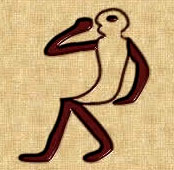 | The Sign of Silence
Reference: |
|
Symbol Code: SM000050 Symbol Name: Wisdom Eyes of Buddha (Category: Desire )
|
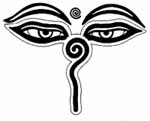 | Often found painted on the Stupas of Tibetan Buddhism, this symbol represents the all seeing eyes of the Buddha, a symbol of the omnipresent compassion of the Bodhisattvas. The small dot depicted between the eyes represents the third eye, a symbol of spiritual awakening. The curious squiggle between the eyes is the Sanskrit numeral one, symbolizing the unity of all things.
Reference: |
|
Symbol Code: SM000051 Symbol Name: Om Mani Padme Hum (Category: Desire )
|
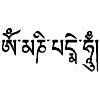 | The mantra Om Mani Padme Hum (literally: “Aum, to the Jewel in the Lotus, hum”) is recited by Tibetan Buddhists to invoke Chenrezi, the Bodhisattva of Compassion. Repeating this mantra accumulates merit and eases negative karma; meditating upon it is believed to purify the mind and body. Spinning prayer wheels, physical or digital, are believed to confer the same benefit as speaking the mantra. It is often recited with the aid of a mala (string of prayer beads.)
Reference: |
|
Symbol Code: SM000052 Symbol Name: Kalash (Kalasa) (Category: Desire )
|
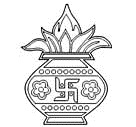 | This symbol, depicting a vase covered with leaves, is a representation of the kalash, a Hindu/Jain ritual implement. The kalash is a clay or copper pot filled with water, and topped with mango leaves and a coconut. The kalash has many symbolic meanings- it is the primordial waters of creation, the soul filled with love and compassion, abundance, and hospitality.
Reference: |
|
Symbol Code: SM000053 Symbol Name: Universal Jain Symbol (Category: Desire )
|
 | This Jain Symbol is a compound, made up of a number of other symbols significant to the Jain religion. The Jain religion, an offshoot of Vedic religion (today’s Hinduism), shares many concepts and beliefs with its cousins Hinduism and Buddhism, and the symbol encompasses the core Jain teachings. The outline of the emblem represents the Jain conception of the universe: The upper, the realm of heaven The lower, the realms of hell The center, the material world where the two intersect.
Reference: |
|
Symbol Code: SM000054 Symbol Name: Shamrock (Trefoil, Cloverleaf) (Category: Desire )
|
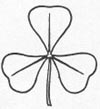 | The Shamrock is the ubiquitous symbol of all things Irish. Although today it is usually regarded as a simple good luck charm or a St. Patrick’s day decoration, it is one of the oldest Celtic symbols.The shamrock is a native species of clover in Ireland. A Catholic legend holds that St. Patrick used it’s three lobes as a device for teaching the Holy trinity. To the Druids who came before, it symbolized a similar “three in one” concept- the three dominions of earth, sky, and sea, the ages of man, and the phases of the moon. In Celtic folklore, the Shamrock is a charm against evil, a belief that has carried over in the modern reliance in the four leafed clover as a good luck charm.
Reference: |
|
Symbol Code: SM000055 Symbol Name: Romuva (Austras Koks) (Category: Desire )
|
 | This is the emblem of the Romuva religion, a revival of the indigenous Pagan religion of Lithuania. The symbol of Romuva is a stylized oak tree, representing the axis mundi, or “world tree,” known in local mythology as Austras Koks, ” tree of dawn,” i.e., a tree of life.The three tiers represent the three worlds: the world of the living, or present-day, the world of the dead, or passed time, and the world to come, the future.The flame represents the ritual offering fire central to Romuva religious practice.The runic inscription here reads, “Romuve,” or sanctuary, the root from which the the word Romuva isderived.
Reference: |
|
Symbol Code: SM000056 Symbol Name: Ausekla Zvaigzne (Category: Desire )
|
 | Aueskla means “star” in Lithuanian, and the Ausekla Zvaigzne (“star cross,” from the root Aust, dawn), or Star of Auseklis, is the emblem of the morning star in the Baltic region- the Latvian God Auseklis, as well as the Lithuanian goddess Ausrine, the daughter of the sun. The symbol is one of many ancient cosmological and magical symbols used in Eastern European folk art, and represents the god/goddess as the personification of the planet Venus.
Reference: |
|
Symbol Code: SM000057 Symbol Name: Hugin and Munin (Category: Desire )
|
 | Hugin and Munin (Norse, “thought” and “memory”) are the twin ravens of Norse mythology. They are the servants of the Norse All-Father, Odin. According to legend, they are sent out each morning and report back to Odin each evening on the reports of the happenings of the world.The examples above are adapted from a Viking picture stone from Gotland, Sweden, called the “Larbro” stone, which depicts scenes of the Norse Gods and the afterlife.
Reference: |
|
Symbol Code: SM000164 Symbol Name: The Coyote Symbol (Category: Desire )
|
 | (Greed and Desires): The coyote symbol represents the the prairie wolf and is small and cowardly, the least imposing of the wolf like animals. In Native American myths and legends the contemptible coyote symbolizes selfishness, deceit and greed. He is often outwitted by the animals who he tries to trick. Those he helps do not show the coyote gratitude. However, despite this the coyote is perceived as a powerful magician bringing the world to some order although this might not have been his intention.
Reference:http://www.warpaths2peacepipes.com/native-american-symbols/coyote-symbol.htm |
|
Symbol Code: SM000165 Symbol Name: Celtic Griffins (Category: Desire )
|
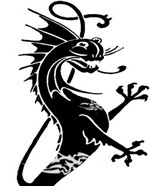 | (Greed and Desires): An ancient creature embraced by many cultures, the Celtic animal griffin is a symbol of duality. Part eagle and half-part lion (depending on the region - even part serpent, horse or dog), the meaning of the griffin reflects is dual physical form by presenting a balance of both good and not so good qualities. The griffin's more likeable qualities include nobility, gentleness, and justice. Depicted on ancient stone tombs, griffins are the guardians and protectors of life, and remain loyal in their protection even in the afterlife. Griffins count nobility, vigilance, virtue and strength among their many positive attributes. The griffin is an incredibly strong symbol, and used only when the mightiest gods' attention needs to be captured, and reserved only when the need is greatest. Misused, or invoked for selfish reasons, the griffin brings about gluttony, vengeance, ferocity, and violence. In Roman texts, the Griffin is strongly aligned with the fire god, Apollo. This makes the griffin a possessor of fiery forces - and not to be trifled with when in partnership with Apollo. Given it's power, and considering it can be just as nefarious as it can be kind, respect must be paid when invoking the spirit of the griffin.
Reference:http://www.whats-your-sign.com/Celtic-animals.html |
|
Symbol Code: SM000166 Symbol Name: Symbol of Disbelief (Category: Desire )
|
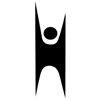 | (Greed and Desires): One of the earliest symbols is not a symbol of disbelief per se. The Humanist movement’s “happy human,” designed by Denis Barrington in 1965 for the International Humanist and Ethical Union. The little figure symbolized the humanist philosophy of people over religious dogma, and while popular with atheists, is not an explicitly atheist symbol.
Reference:http://symboldictionary.net/?p=2087 |
|
Symbol Code: SM000167 Symbol Name: Menat (Menit, Menyat) (Category: Desire )
|
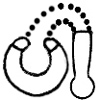 | (Greed and Desires): The Menat (Menit, Menyat) was an emblem of the goddess Hathor, a beaded necklace or collar with a counterweight which symbolized the life-force. The necklace was worn by priests and priestesses of Hathor, and by pharaohs and their queens. The menat was a frequent offering to the goddess, and menat amulets were worn to attract prosperity and good fortune.
Reference:http://symboldictionary.net/?p=584 |
|
Symbol Code: SM000168 Symbol Name: Monstrance (Ostensoria) (Category: Desire )
|
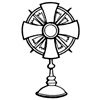 | (Greed and Desires): The monstrance is the ceremonial vessel used in during the Roman Catholic Mass to display the consecrated communion host. Although the monstrance has taken many shapes during the period of its use, it typically, takes the shape of a solar cross, with a clear central area made of glass or crystal. The host is usually placed in a small crescent shaped holder within the crystal, called a lunette due to its moon-like shape.Upon the death of Pope John Paul II, the Vatican televised broadcast only an empty monstrance while preparing to announce the Pontiff’s passing.
Reference:http://symboldictionary.net/?p=2262 |
|
Symbol Code: SM000191 Symbol Name: Celtic Symbol Mandalas (Category: Desire )
|
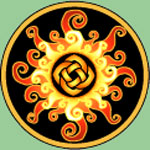 | (Desire and Misery): The Celtic knot mandala beckons us to fall into to it for a glimpse into the inner workings of our lives. As we delve in hypnotic flow with this mandala, we are able to see how our decisions have affected our lives, and those lives around us. Further, we are able to visualize how our lives are interconnected with those of our ancestors. Let your imagination run free each time you lay eyes on this beautifully embroidered design.
Reference:http://www.whats-your-sign.com/Celtic-symbol-mandala.html |
|
Symbol Code: SM000192 Symbol Name: Triskelion Symbol (Category: Desire )
|
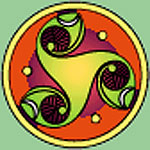 | (Desire and Misery): In a nutshell, the triskelion Celtic symbol meaning deals with competition and man's progress. The Greek term triskelion literally means "three-legged," and appropriately, this sign looks very much like three legs running.The triskelion (also referred to as triskele, triquetra or fylfot) Celtic symbol meaning holds two major components of symbolism.
Reference:http://www.whats-your-sign.com/triskelion-celtic-symbol-meaning.html |
|
Symbol Code: SM000193 Symbol Name: Quincunx (Category: Desire )
|
 | (Desire and Misery): An arrangement of five figures within a square. Historically, it has infused the worlds of nature, man and the stars. As an ancient alchemy symbol, it represents the whole being more than the sum of its parts. In the alchemical mineral world, the quincunx occurs in the formation of metals, in atomic structures. Additionally the quincunx represents (wo)man's ability to cross from four to five his/her nature. Meaning we all possess the four levels of physical matter (stone, plant, animal, man) and we are able to ascend from these four elements to the final fifth – which is godlike or enlightened stature.
Reference:http://tattoosymbolism.blogspot.in/2012/03/alchemy-symbol-meaning-in-tattoos.html |
|
Symbol Code: SM000194 Symbol Name: Five Tufts (Category: Desire )
|
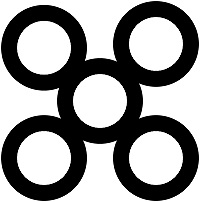 | (Desire and Misery): Symbol of priestly office, loyalty andadroitness “This symbol is said to be the hairstyle of joy. It is thetraditional hairstyle of the priestesses. … The design of the adinkra symbolmpuannum resembles the way the priestesses’ hair was tied. … It alsorepresents the devotion and faithfulness one displays when doing a taskrequired of one. In addition, mpuannum means loyalty or the embodiment of loftyduty to a desired goal.” – W. Bruce Willis, The Adinkra Dictionary
Reference:http://www.siliconafrica.com/african-symbols-for-creative-design/ |
|
Symbol Code: SM000319 Symbol Name: The Hand of Eris (Category: Desire )
|
 | (Lust and Desires): The Hand of Eris is a symbol of the Discordian religion, symbolizing Eris, the goddess of chaos and discord. Pictured in the Principia Discorida, it is described: “The official symbol of POEE is here illustrated. It may be this, or any similar device to represent two opposing arrows converging into a common point. It may be vertical, horizontal, or else such, and it may be elaborated or simplified as desired. The esoteric name for this symbol is The Five Fingered Hand of Eris, commonly shortened to The Hand.
Reference:http://symboldictionary.net/?s=lust |
|
Symbol Code: SM000320 Symbol Name: Kneph (Winges kneph, Thelemic Hadit) (Category: Desire )
|
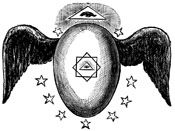 | (Lust and Desires): A typical illustration of the Egyptian deity Kneph (soul-breath). Like the Greek pneuma, and the Hebrew Ruach, kneph represented the life-force. It was the breath of Kneph who brought both the gods and man to life.In Alchemy, the kneph variously represented the holy spirit, the state of volatility (mercury), or the creative force.In Freemasonry, the kneph was the cosmic egg, the state of potentiality.In Aleister Crowley’s Thelemic symbolism, the kneph represents Hadit, the “fire in the heart of matter,” the upward-rising force of kundalini.
Reference:http://symboldictionary.net/?s=lust |
|
Symbol Code: SM000321 Symbol Name: Maori Amulets (Manaia, Hei Matau, Koru) (Category: Desire )
|
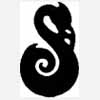 | (Lust and Desires): Maori amulets are traditionally carved from whale-bone or nephrite (a jade-like stone), although modern copies in jadeite and cow-bone are common. Some of the more popular motifs are illustrated below:The images below are popular representations of mythical bird-headed beings from Maori mythology called Manaia. Manaia are spirit guardians and messengers of the gods, and are depicted in many forms, from large wood-carvings to small amulets.
Reference:http://symboldictionary.net/?s=lust |
|
Symbol Code: SM000322 Symbol Name: Eight-pointed Star (Category: Desire )
|
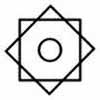 | (Lust and Desires): The particular eight-pointed star (or octogram) pictured here is unusual in that it has multiple meanings, depending on context. The original emblem of two overlapping squares, often with a circular ornament, is called a rub el hisb (Arabic, quarter-group), an ornament used to mark the end of passages in the Q’uran. This symbol, like all symbols related to Islam, is not official nor heavily symbolic.An identical glyph serves as the emblem of the Melchizedek priesthood of the Church of Latter-Day Saints, who view it as a continuation of the priesthood of biblical patriarchs. The emblem is patterned after a similar glyph found in a medieval depiction of Melchizedek, but is of relatively recent usage in Mormonism. The star in this context would most likely have been a symbol of renewal and rebirth through baptism.
Reference:http://symboldictionary.net/?s=lust |
|
Symbol Code: SM000323 Symbol Name: Point in Circle (Category: Desire )
|
 | (Lust and Desires): The point within the circle is another of the many geometric symbols used in Freemasonry. It is also one of the more complex and interesting. The emblem is a very old one, a solar-phallic symbol used in ancient Egypt to represent the eternal nature of the sun god Ra. The lines which enclose the circle call to mind the akhet, the ancient ‘gate’ of the sun, a symol of rebirth and resurrection.In the Masonic Lodge, the emblem is associated with St. John the Baptist and St. John the Evangelist, whose feast days fall on the summer and winter solstices.
Reference:http://symboldictionary.net/?s=lust |
|
Symbol Code: SM000324 Symbol Name: Keystone (Masonic Keysone, Royal Arch Symbol) (Category: Desire )
|
 | (Lust and Desires): The keystone is a significant symbol in the York Rite of Freemasonry, where it figures in the unfolding symbolic tale of Hiram the builder. In masonic lore, Hiram is the inventor of the keystone, and its significance is lost upon his assassination. The ritual narrative centered around this stone recalls the biblical “stone the builders refused,” as the uninitiated, not knowing the purpose of the oddly-shaped stone, consign it to the rubbish heap. It is only rediscovered when King Solomon inquires after its whereabouts.The letters inscribed are short for the coded phrase: “Hiram The Widows Son Sent to King Solomon,” an obvious cipher, the meaning of which is likely lost.
Reference:http://symboldictionary.net/?s=lust |
|
Symbol Code: SM000325 Symbol Name: Dreidel (s’vivon) (Category: Desire )
|
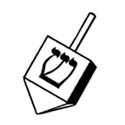 | (Lust and Desires): The Dreidel is an easily recognized symbol of the Jewish holiday Chanukkah. The dreidel (the word dreidel is a corruption of the German word for ‘top’) is a four sided spinning top inscribed with Hebrew characters, adapted from an old German gambling game. As rules prohibiting gambling games were traditionally relaxed during the holiday, the dreidel became inseparably associated with Chanukah.
Reference:http://symboldictionary.net/?s=lust |
|
Symbol Code: SM000326 Symbol Name: 47th Problem (Bride’s Chair) (Category: Desire )
|
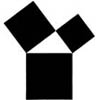 | (Lust and Desires): This simple illustration is easily recognizable in Freemasonry as an illustrated proof of the Pythagorean Theorem, better known in Masonry as the 47th problem of Euclid. (It is so named because it was number forty-seven in a collection of geometrical problems produced by the Alexandrian mathematician Euclid) This ubiquitous emblem is found on badges and jewels, lodge decorations and more, and has been associated with Masonry for hundreds of years.
Reference:http://symboldictionary.net/?s=lust |
|
Symbol Code: SM000327 Symbol Name: Golden Ratio (Golden Mean, Golden Rectangle, Phi) (Category: Desire )
|
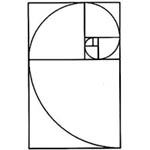 | (Lust and Desires): The Greek mathematician Pythagoras is credited with the discovery of the Golden Rectangle. The Golden Rectangle is built on the “golden ratio” or “golden proportion,” which is determined by the irrational number known as Phi. (Symbolized by its namesake, the Greek letter phi:)To put it simply, a golden rectangle is a rectangle divided in such a way as to create a square and a smaller rectangle that retains the same proportions as the original rectangle. To do this, one must create a rectangle based on the golden ratio.
Reference:http://symboldictionary.net/?s=lust |
|
Symbol Code: SM000328 Symbol Name: Miraculous Medal (Marian Monogram) (Category: Desire )
|
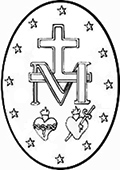 | (Lust and Desires): The emblem at right is one of many examples of “Marian Monograms” employed by devotees of the Virgin Mary within the Catholic Church. This particular example appears on the reverse of the “miraculous medal,” based on a design received in a vision of the Virgin by St. Catherine Labouré in 1830. According to the legend, Theresa was directed by Mary to fashion the medal as a symbol of charity.The intertwined cross and initial “M” are meant to illustrate the scene of Jesus’ crucifixion described in the Gospel of John, and represents Mary at the foot of the cross. The twelve stars depicted represent the twelve tribes of Israel. The two hearts are, respectively, the Sacred Heart of Jesus and the Immaculate Heart of Mary.
Reference:http://symboldictionary.net/?s=lust |
|
Symbol Code: SM000395 Symbol Name: The Egg and the Serpent (Category: Desire )
|
 | The philosophical or cosmic egg is another nearly universal symbol. Alchemically, the egg is a symbol of the cosmos, as it is in a multitude of folk legends. In Hindu cosmology, it is the source of the universe. The egg as a container of the universe is found in many ancient religions. The egg symbolizes birth and potential. It contains within a miniature sun, and it features prominently in solar mythology. The gods Vishnu, Phanes, and Mithras, are all “egg born” solar deities. Another solar entity, the rooster, is also born of an egg.
Reference:http://symboldictionary.net/?s=desires |
|
Symbol Code: SM000396 Symbol Name: Kapala Mala (Category: Desire )
|
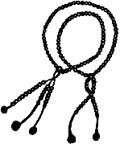 | A kapala-mala is a mala string made of skulls carved from human bone. Pure Land and other Buddhist traditions use a double-fringed strand of beads called juzu (counting beads) or nenju (“thought beads”). These typically consist of 108 small beads symbolizing the 108 earthly desires which must be overcome; some have larger focal beads to represent the Bodhisattvas.Juzu are used for prayers in much the same way as a Catholic rosary, or may simply be held during meditation or contemplation. *A Bodhisattva (Sanskrit, “essence of enlightenment”) is a highly spiritually developed being who stops short of Buddhahood in order to aid others in attaining enlightenment.
Reference:http://symboldictionary.net/?s=desires |
|
Symbol Code: SM000397 Symbol Name: NYAME DUA (Category: Desire )
|
 | "tree of god" – altar symbol of God's presence and protectionThe Nyame Dua is a sacred spot where rituals are performed. Erected in front of the house or compound, it is crafted from a tree that has been cut where three or more branches come together. This stake holds an earthenware vessell filled with water and herbs or other symbolic materials for purification and blessing rituals.
Reference:http://www.adinkra.org/htmls/adinkra/nyamedua.htm |
|
Symbol Code: SM000398 Symbol Name: NEA OPE SE OBEDI HENE (Category: Desire )
|
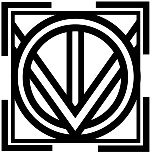 | "he who wants to be king " symbol of service and leadershipFrom the expression "Nea ope se obedi hene daakye no, firi ase sue som ansa" meaning "He who wants to be king in the future must first learn to serve."
Reference:http://www.adinkra.org/htmls/adinkra/neaope.htm |
|
Symbol Code: SM000399 Symbol Name: WOFORO DUA PA A (Category: Desire )
|
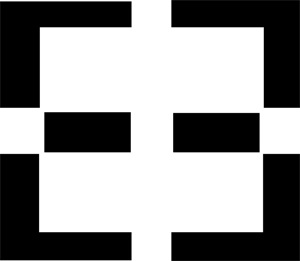 | "when you climb a good tree" symbol of support, cooperation and encouragementFrom the expression "Woforo dua pa a, na yepia wo" meaning "When you climb a good tree, you are given a push". More metaphorically, it means that when you work for a good cause, you will get support.
Reference:http://www.adinkra.org/htmls/adinkra/wofo.htm |
|
Symbol Code: SM000400 Symbol Name: ME WARE WO (Category: Desire )
|
 | "I shall marry you " symbol of commitment, perseveranceFrom the expression "No one rushes into the job of mixing the concrete for building the house of marriage."
Reference:http://www.adinkra.org/htmls/adinkra/mewarewo.htm |
|
Symbol Code: SM000401 Symbol Name: Nuit (Nut, Nwt, Nathor) (Category: Desire )
|
 | The Goddess Nut (Nuit, Nwt, Nathor). Nut (noot) is the Egyptian Goddess of the sky, representing the fullness of the cosmos. She is usually depicted nude, a body made of stars, arching over the world. In Egyptian mythology, Nut swallowed the sun every evening, and gave birth to it every morning. She was the mother of the deities Osiris, Isis, Seth and Nephthys. Her name is the root of the word “night” in a number of tongues.
Reference:http://symboldictionary.net/?p=583 |
|
Symbol Code: SM000402 Symbol Name: Sistrum (Sheshesht) (Category: Desire )
|
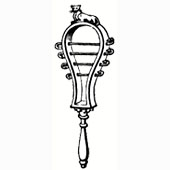 | A sistrum is an ancient Egyptian women’s ritual instrument, resembling a tambourine with a handle. The typical sistrum is shaped like an ankh, consists of a handle topped with a metal or wooden loop containing wires strung with metal plates that jingled when shaken.The sistrum was used primarily in the worship of the Goddesses Isis, Hathor, and Bast. According to the historian Plutarch, the noise of the sistrum was effective to keep Typhon, the god of chaos, at bay through its constant movement. The sistrum is still used today by practitioners of the Kemetic (Reconstructed Egyptian) faith.
Reference:http://symboldictionary.net/?p=550 |
|
Symbol Code: SM000403 Symbol Name: Sma Amulet (Sema) (Category: Desire )
|
 | The Sma represented the union of the kingdoms of upper and lower Egypt, and occasionally stood in for the axis mundi, or earth-axis. It is described variously as the lungs and attached windpipe, or genitals in sexual union, and appears to have been depicted as both at times- the double meaning is certainly intentional. An emblem of rulership, the sma was placed on the chest of a mummy to give it breath (life) in the underworld.The sma was also used as a charm for fidelity in love.
Reference:http://symboldictionary.net/?p=533 |
|
Symbol Code: SM000404 Symbol Name: Crook and Flail (Category: Desire )
|
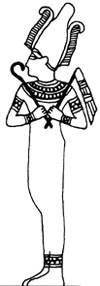 | The Crook and Flail are the emblems of the Egyptian God Osiris. They were the symbols of divine authority carried by Egyptian Pharaohs in State ceremonies.The crook and flail are Shepherd’s tools -one of the epithets of Osiris was “Good shepherd.”As symbols of kingship, they were fashioned into elaborate scepters used in the coronations of Pharoahs.The crook and flail originally belonged to a minor agricultural deity, Anedijti, and were later adopted by followers of Osiris. Originally emblems of crops and livestock, they later became symbols of purification and divine guidance.
Reference:http://symboldictionary.net/?p=634 |
|
Symbol Code: SM000405 Symbol Name: Triratna, (Tiratana, Tisarana, Triple Gem, Three Treasures, Threefold Refuge) (Category: Desire )
|
 | The tiratana is Buddhist emblem symbolizing the three jewels, or “refuges” of Buddhism. The symbolism is likely drawn from the Vedic trisula, which has similar interpretations.The three Refuges are: the Buddha, the Dharma (the teachings of the Buddha), and the Sangha (the community of believers), as well as additional layers of symbolism, such as: The three virtues of the Buddha:wisdom, purity, compassionThe three parts of the Pali Canon, or Tripitaka (“three collections,” the earliest Buddhist canon), which includes the Vinaya, guidelines for behavior, Sutra, discourses and stories of the Buddha, and Abhidharma, Metaphysical teachings.
Reference:http://symboldictionary.net/?p=1848 |
|
Symbol Code: SM000406 Symbol Name: Uffington Horse (White Horse) (Category: Desire )
|
 | This gigantic earthwork best known as the “Uffington Horse,” is located on a hillside in Oxfordshire, England, and dates to the Bronze age. Measuring almost four hundred feet long, the figure was created by filling dug trenches with powdered chalk.The horse is one of many chalk figures scatted across the English countryside. It has been speculated that the horse is possibly a remnant of worship of the Celtic Goddess Epona, or the sun God Belenus. Others note the extended tail and contend that the “horse” is actually a dragon. The figure may be a remnant part of a giant zodiac comprised of chalk figures, the majority of which are now missing.
Reference:http://symboldictionary.net/?p=41 |
|
Symbol Code: SM000420 Symbol Name: Harpocrates (Category: Desire )
|
 | In late Greek mythology as developed in Ptolemaic Alexandria, Harpocrates (Ancient Greek: Ἁρποκράτης) is the god of silence. Harpocrates was adapted by the Greeks from the Egyptian child god Horus. To the ancient Egyptians, Horus represented the newborn Sun, rising each day at dawn. When the Greeks conquered Egypt under Alexander the Great, they transformed the Egyptian Horus into their Hellenistic god known as Harpocrates.
Reference:http://en.wikipedia.org/wiki/Harpocrates |
|
Symbol Code: SM000421 Symbol Name: Point in Circle (Solstices, circumpunct) (Category: Desire )
|
 | The point within the circle is another of the many geometric symbols used in Freemasonry. It is also one of the more complex and interesting. The emblem is a very old one, a solar-phallic symbol used in ancient Egypt to represent the eternal nature of the sun god Ra. The lines which enclose the circle call to mind the akhet, the ancient ‘gate’ of the sun, a symol of rebirth and resurrection. The point and circle as the monad, from Achilles Bocchius’ illustration of Hermetic Silence.
Reference:http://symboldictionary.net/?s=silence |
|
Symbol Code: SM000422 Symbol Name: Joachim and Boaz (Mercy and Severity) (Category: Desire )
|
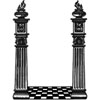 | Jachim and Boaz are the pair of symbolic pillars (with Boaz on the left) described in the biblical account of the Temple of Solomon and featured prominently in Masonic temples.In the Jewish mystical kabbalah, Joachim and Boaz are the left and rightmost pillars of the tree of life- mercy and severity, or strength. Jachim represents the male polarity of the universe, light, motion, activity, the electron. Boaz represents the female polarity of the universe, darkness, passivity, receptivity, and silence. The pillars are similar in concept to the Eastern Yin Yang, representing opposites in balance.
Reference:http://symboldictionary.net/?s=silence |
|
Symbol Code: SM000423 Symbol Name: Celtic Animal Symbols: Deer, Stag (Category: Desire )
|
 | The deer was arguably the most important animal to the early Celts. Before agriculture or animal husbandry; venison was a staple food. Some of the oldest surviving examples of pre-Celtic Neolithic art depicts shape-shifting shamans in the form of deer, who may prefigure the shape-shifting gods and heroes of Celtic legend, as well as Cernunnos, the stag-horned deity of healing and plenty.
Reference:http://symboldictionary.net/?p=932 |
|
Symbol Code: SM000424 Symbol Name: Celtic Animal Symbols: Hound, Wolf, Dog (Category: Desire )
|
 | In Celtic myth tales, hounds are emblematic of courage, extreme loyalty, and honor. Hounds were prized as companions of the hunt and travelers between worlds. Dogs were closely associated with healing.Gallic gods of healing springs had sacred dogs, and votive offerings to these gods often portrayed dogs and their owners.Hounds, invariably magical, were the constant companions of many Celtic heroes. Irish Filidh (seers) chewed the meat of a dog in a ritual to gain prophetic vision. To be called “hound” was an honorable nickname for a courageous warrior; the name of the god Cuchulain is literally “Hound of Culann;” violating a geas (sacred taboo) on the eating of dogflesh leads to the hero’s death. The mother of the god Lugh, in whose honor the Lughnassa festival was celebrated, was killed while in the form of a small dog.
Reference:http://symboldictionary.net/?p=936 |
|
Symbol Code: SM000544 Symbol Name: Symbols of the Saints: St Agnes (Category: Desire )
|
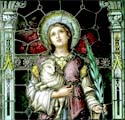 | St Agnes, a martyr, carries a lamb, symbolizing the virginity she died to protect. The legend of the Roman saint, whose name means “chaste,” tells that she was brutally executed after refusing to marry the son of a Roman official. She is sometimes depicted covered in hair, a covering which kept the virgin saint protected from rape at the hands of her executioners.
Reference:http://symboldictionary.net/?s=desires |
|
Symbol Code: SM000545 Symbol Name: Symbols of the Saints: St Anthony (Category: Desire )
|
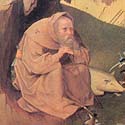 | St Anthony is the desert hermit whose struggle with demons was a hugely popular subject in renaissance art. Anthony is symbolized with a walking stick and pilgrim’s cloak, with blue theta or “T” (short for Theos, God) on his cloak, and is often pictured with the raven who is said to have brought him his daily meal during his solitary existence in the desert. A pig symbolizing earthly desires the saint overcame often accompanies him on his travels.
Reference:http://symboldictionary.net/?s=desires |
|
Symbol Code: SM000546 Symbol Name: Harp (Category: Desire )
|
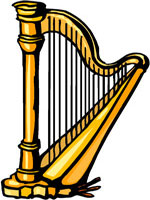 | The Harp is a symbol of love in the form of lyrical art, poetry, and music. The Harp shares mythical connections to the Celts representing the bridge of love connecting heaven and earth. In Norway and Iceland, Harpstrings formed a ladder symbolizing the ascent to higher states of love and pathways leading to paradise. King David played the Harp to the Lord to express his devotion and love.
Reference:http://www.whats-your-sign.com/love-symbols.html |
|
Symbol Code: SM000547 Symbol Name: Cupid (Category: Desire )
|
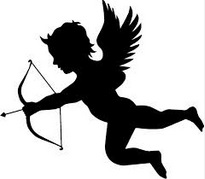 | Cupid or Eros means desire in Greek. According to Hesiod, Eros was the deity who came from Chaos ("The Yawning Void") and represented the primal forces of desire. Eros is said to have been born from the union of Aphrodite and Ares. Known as Amor (meaning love) to the Romans, the Cupid was often shown blindfolded in art to symbolize love's blindness.
Reference:http://www.whats-your-sign.com/love-symbols.html |
|
Symbol Code: SM001062 Symbol Name: Animal Love Symbol Meaning for Swan (Category: Desire )
|
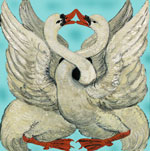 | The Swan holds a multitude of representations including love, grace, purity, beauty and sincerity. Another attribute of Aphrodite, the Swan also symbolized chastity. The Celts believed the Swans were benevolent dieties and legend has it that their images were forged into silver medallions worn around the neck for protection. In Hinduism, the Swan is known as the Hamsa bird and signifies the divine mind and the breath of spirit. The Swan is also another symbol of the Virgin Mary and the purity and love she symbolizes.
Reference:http://www.whats-your-sign.com/love-symbol-animal.html |
|